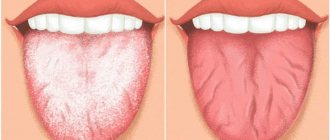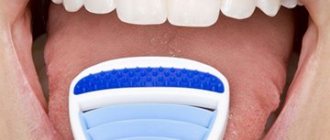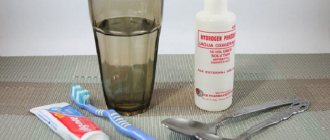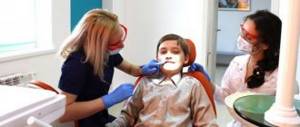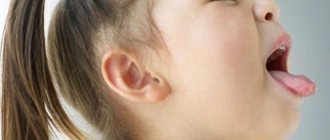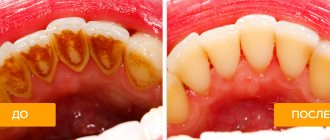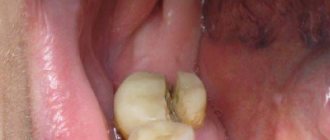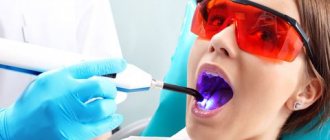Did our ancestors clean their tongues?
People began using tongue cleaning devices at least five centuries ago. An example of this is the mention of the need to cleanse this organ of our body in the treatises of the 10th century AD. Uzbek doctor Avicenna. For the most effective procedure, he recommended using cypress cones and tree slivers, which are rich in essential oils. In ancient China, members of the nobility used a tongue scraper to clean their tongues before each meal, as it was believed that thanks to this procedure they could fully appreciate the taste of the dishes. Residents of our country made special scrapers from silver, which disinfected the oral cavity and prevented various inflammations such as mouth ulcers, candidal stomatitis, various types of glossitis, etc.
Using floss
Dental floss is designed to clean the interdental space and end surfaces of teeth. Getting pieces of food and removing soft plaque from these hard-to-reach places without a special device is very problematic, and floss is ideal for this. It can be round, flat, voluminous, ribbon, with or without impregnation. The dentist will tell you which type of thread is best for a particular patient.
It is advisable to floss after every meal. To do this, you need to take a piece of thread 30-40 cm long and, wrapping it around your index fingers, insert it into the interdental space. The lateral surfaces of both teeth are cleaned one by one, then the manipulation is repeated.
Cleaning your tongue with a tongue scraper
Nowadays, tongue scrapers take pride of place in the list of oral hygiene devices. Almost all of them are made of plastic and are a nozzle with a spoon-shaped tip. This excellent tongue and cheek remover needs to be replaced as often as toothbrushes. If you use it together with a rinse aid, the quality of the procedure will be one level higher. You can buy a tongue scraper at a pharmacy or order it from an online store.
Features of tongue hygiene
In any discussion about oral hygiene, you are unlikely to find information on tongue care. But the tongue is a very important organ that performs many functions:
1. The tongue is an organ with which a person makes various sounds, including speech; the timbre of the voice largely depends on it. 2. The tongue distributes food in the oral cavity and participates in the formation of the food bolus. 3. The tongue is an organ of taste (has taste buds). 4. Thanks to the sensitive papillae on the back of the tongue, we distinguish cold food from hot food. 5. The tongue is a muscular organ that not only participates in the act of chewing, but also closes the entrance to the nasopharynx, the respiratory tube (trachea), prevents food from entering the nasal cavity or trachea and settling on the vocal cords, that is, it performs a protective function. 6. The tongue is involved in the implementation of facial functions.
Tongue hygiene includes removing plaque, mucus, and food debris using a special brush or scraper. If they are unavailable, you can use a regular toothbrush, preferably a soft or medium-hard one. Cleaning your tongue is done after you have brushed your teeth and rinsed your mouth. Using sweeping movements, plaque and mucus are removed from the tongue in the direction from root to tip. Particular attention to tongue hygiene should be paid to people who have a folded or “geographical” tongue (when there are deep grooves and folds on the surface of the tongue). They can accumulate a large amount of mucus and plaque, which is a favorable environment for the reproduction and activity of microorganisms and can cause inflammation. When examining the tongue, attention should be paid to its size, outline, condition of the surface, edges, and color. Changes may indicate various pathological conditions (See, for example, Fig. 1).
Rice. 1 Clinical interpretation of local trophic changes in the tongue (according to V. Lad):
| - increased sensitivity of the large intestine; 2 - toxins in the colon (white); 3 - toxins in the gastrointestinal tract; 4 - chronic disorders in the colon; 5 — chronic enterocolitis (tooth imprints); 6 — hypofunction of the lungs; 7 - chronic bronchitis (foamy plaque); 8 — bilateral pneumonia (brown); 9 - renal disorders; 10 - weakness of cardiac activity; 11 - tremors of the tongue (thyrotoxicosis, neurasthenia, alcoholism, hidden fear or anxiety); 12 - excitation in the spinal column (midline); 13 - pain in the lumbar region (curvature of the line at the root of the tongue); 14 - pain in the middle part of the back (curvature of the line in the center of the tongue); 15 - pain in the cervical vertebrae (curvature of the line at the tip of the tongue). |
With anemia, that is, anemia and heart failure, the color of the tongue is pale. With liver disorders, and especially the gallbladder, the color of the coating on the tongue becomes yellow. The severity of the color scheme is determined by the severity of the process.
The smoothness of the papillae and the formation of a shiny red spot in the center of the tongue is most often associated with disorders in the intestines.
In case of swelling or other reasons for the increase in the size of the tongue, imprints of teeth or orthopedic structures (prostheses) remain along its edges. More often, such phenomena are associated with intestinal dysfunction. However, if, after unsuccessful prosthetics, an increase in the tongue and tooth marks occurs on only one side, then most likely this is the result of injury from the prosthesis. At the same time, swelling and inflammation may be preceded by other types of injuries: for example, the patient bit his tongue after dental treatment under anesthesia or was pricked with a fish bone.
It is believed that all internal organs have their representations in the language. So, the heart is presented in the central part, closer to the tip. The lungs have their representations to the right and left of the projection area of the heart and slightly in front of it. There are a number of diagrams of the projection zones of internal organs on the tongue (Fig. 2 and 3).
Rice. 2 Diagram of projection zones of internal organs on the tongue (according to M. Nechaev):
| 1 - right lung; 2 - left lung; 3 - liver; 4 - spleen; 5 - pelvic organs. |
Rice. 3 Diagram of projection zones of internal organs on the tongue (according to V. Lad)
During a massive alcohol attack, when the liver cannot cope with detoxification of the body, the tongue is covered with an abundant dark brown, almost black coating, which is located in the central part and closer to its root, that is, in the places where the liver, gallbladder, pancreas, spleen and intestines. Abundant and active rinsing can lead to increased exfoliation of the epithelium from the surface of the tongue, new cells do not have time to keratinize and the growth of papillae, especially filiform ones, occurs. A so-called black hairy tongue is observed, which can be mistaken for a malignant tumor. Ulcers and rashes on the surface of the tongue can be associated with herpes infection, overwork, stress, chronic fatigue syndrome, and vitamin deficiency. Ulcers can also be caused by more serious infections. For example, the primary syphilitic affect - chancre - can be located in different parts of the tongue, depending on the location of the introduction of the pale spirochete. You can clean your tongue either with or without toothpaste. The brush should be slightly moistened, as a dry brush can injure the tongue. When you are just starting to master tongue cleaning, approaching the root of the tongue can provoke a gag reflex, especially in smokers who have a very sensitive mucous membrane of the pharynx that is constantly irritated by smoke. It is necessary to gradually accustom your body to this procedure, starting with using a softer brush with even bristles. It should be moistened with warm water. After several sweeping movements, the brush must be rinsed to remove mucus accumulated on the bristles and deflated epithelium. You should not immediately use the brush together with the toothpaste, since the foam of the toothpaste, if it gets into the throat, can also provoke a gag reflex. As you get used to the procedure, you can switch to cleaning your tongue with a paste, without using highly foaming pastes.
Tongue cleaning spoon
A tongue cleaner is just as great for removing plaque and bad breath as other tongue cleaners. It is a nozzle with a spoon-shaped tip. Using this water-supplying nozzle, you can clean your tongue quite gently and effectively. It is known, for example, that yogis use a wooden spoon or clean their tongue with three fingers wrapped in a clean bandage. You can also use an ordinary teaspoon, but then only for cleaning and, of course, individually.
Brushing your teeth with a brush and toothpaste
It is ideal if a professional selects the brush and paste. Those who do this themselves should first of all pay attention to the stiffness of the bristles. In most cases, brushes with medium-hard bristles are optimal for people who have no dental contraindications for their use. All pastes are divided into hygienic and therapeutic and prophylactic. The former, provided RDA (abrasiveness index) values are within 250 (the lower the index, the safer the enamel paste) can be used without fear.
You should brush your teeth with sweeping movements twice a day, immediately after waking up and immediately before going to bed. The crown and back of the teeth can be treated with reciprocating or circular movements. The main task is to rid teeth of plaque and polish the enamel. The brush needs to be changed every 2-3 months.
What happens to your teeth if you don't brush them? Infographics Read more
Tongue scraper brush
Many companies specializing in the manufacture of oral hygiene products offer so-called tongue scrapers. This device is a combination of a brush and a scraper; it has an elongated round shape with soft bristles. Thanks to its flat shape, cleaning the tongue is much easier (does not cause a gag reflex). You can also find brushes on sale that have bristles on one side and special rubber or plastic relief strips on the other.
Healthy and unhealthy coating on the tongue: how to determine
Even in the time of Hippocrates, healers asked patients to stick out their tongues. By assessing the thickness and color of the organ, doctors made conclusions about the state of human health. Centuries have passed, but this method of primary diagnosis is still used by many therapists, dentists, pediatricians, and otolaryngologists.
The plaque itself does not cause disease. It has various causes for its formation: poor hygiene, smoking, dyes in products, diseases of the teeth and oral cavity. If you are healthy, do not be surprised by the appearance of deposits on your tongue in hot weather, in the morning after waking up, or during the day after eating. This is normal and should not cause concern. The pale pink coating has almost no odor, changes color when using coloring products, and is easily removed with proper hygiene.
Pathology is considered to be a very dense coating through which the color of the tongue is not visible. Usually the deposits smell unpleasant, redness and cracks are visible on the surface, and after cleansing the condition of the tongue does not change. Unhealthy plaque can be brown, green, yellow and even black.
Is it possible to clean your tongue with a toothbrush?
Yes, an ordinary toothbrush with a small amount of toothpaste is often used to clean the tongue. In this case, a soft or medium-hard brush will be more suitable for you. To clean your tongue, you can also use a toothbrush with a special surface on the opposite side of the bristles. After you have brushed your teeth and rinsed your mouth, you just need to turn the brush over and start the procedure. Movements should be carried out in the direction from the back of the tongue to its tip. For the procedure, you can use not only a regular toothbrush, but also an electric or ultrasonic one, as well as an irrigator. If you are the owner of one or the other, then you just need to purchase an additional attachment for cleaning your tongue.
Insufficient cleansing of the tongue leads to the development of bacteria, which, in turn, can affect the occurrence of bad breath, diseases such as glossitis, stomatitis, caries, etc. Therefore, it is necessary to remember the hygiene of the entire oral cavity - teeth, gums and tongue.
The appearance of such formations has various reasons and factors.
- Decreased immunity.
- Dental diseases (gingivitis, stomatitis, caries, periodontitis, etc.).
- Infectious diseases.
- Gastrointestinal problems.
- Infection of the body with helminths.
- Pathologies of the heart, lungs, thyroid gland.
- Taking medications, etc.
In difficult cases, when plaque is one of the accompanying symptoms of serious diseases, consult a doctor. The disease must be identified and cured, otherwise no means to improve the microflora will help.
Using rinse aid
A hygiene product that should be in every bathroom. It has preventive and some therapeutic properties. Removes food debris from hard-to-reach places, disinfects the oral cavity, suppresses the activity of pathogenic microflora, and freshens breath. There are rinses that help strengthen tooth enamel and have a hemostatic, anti-inflammatory, and anti-caries effect.
Rinse aid, like floss, must be used after every meal. To do this, you need to take 3-4 teaspoons of the product (15-20 ml) into your mouth and rinse it thoroughly for about a minute. After this, you can spit out the liquid. There is no need to rinse your mouth after using the mouthwash.
Come on, breathe! What Causes Bad Breath Read More
Using an irrigator
This is a portable device for removing soft plaque and cleaning teeth in hard-to-reach places. The operating principle is based on the generation of a pulsating jet. Both ordinary water and rinse aid can be used as a filler. The use of the latter gives the irrigator antibacterial or other special properties, which depends on the composition of the product.
Like floss and rinse, it is recommended to use the irrigator after every meal. To do this, you need to turn on the charged device and direct the jet into the interdental space, moving from the roots of the teeth to the crown part. The irrigator cannot be considered as an alternative to a brush, floss or rinse; it serves as an effective addition to them.
By the way, in addition to soft plaque, there are also hard deposits that cannot be removed at home, as well as a number of other manipulations, such as root polishing. Therefore, it is advisable to perform professional hygiene at the dentist approximately once every 6 months.
